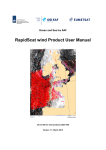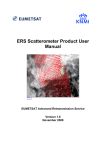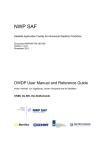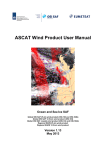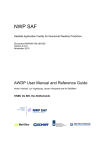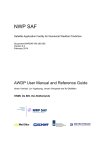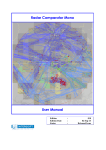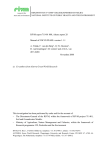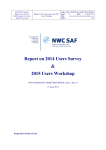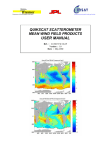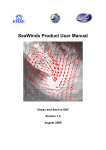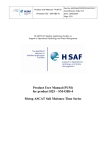Download Oceansat-2 Wind Product User Manual
Transcript
Oceansat-2 Wind Product User Manual Ocean and Sea Ice SAF OSI SAF 50-km wind product (OSI-105) Version 1.3 May 2013 SAF/OSI/CDOP2/KNMI/TEC/MA/140 DOCUMENT SIGNATURE TABLE Prepared by : Name Date O&SI SAF Project May 2013 Signature Team Approved by : O&SI SAF Project May 2013 Manager DOCUMENTATION CHANGE RECORD Issue / Revision Date : Version 1.0 Dec 2011 Version 1.1 Jun 2012 Change : Minor Version 1.2 Sep 2012 Major Version 1.3 May 2013 Minor Description : Draft version Minor editorial changes, comments of PCR included Version for ORR, removed information which is now in ATBD OWDP update for ISRO data v1.4 KNMI, De Bilt, the Netherlands Reference: SAF/OSI/CDOP2/KNMI/TEC/MA/140 Cover illustration: OSCAT wind field of hurricane Katia retrieved in the western Atlantic at 50 km WVC spacing on 7 September 2011, approximately 4:15 UTC, overlaid on a GOES IR satellite image. The orange dots are rejected WVCs, the purple dots indicate WVCs for which the land flag is set. The two orange arrows near the hurricane centre failed the 2DVAR spatial consistency check. OSI SAF Oceansat-2 Wind Product User Manual version 1.3 May 2013 2 SAF/OSI/CDOP2/KNMI/TEC/MA/140 Contents 1. Introduction.......................................................................................................................4 1.1. Overview...................................................................................................................4 1.2. Disclaimer .................................................................................................................4 1.3. References ...............................................................................................................5 1.4. Useful links ...............................................................................................................5 1.5. Limitations of the OSCAT winds ...............................................................................5 1.6. History of product changes .......................................................................................6 2. The OSCAT scatterometer ...............................................................................................7 2.1. Instrument description ..............................................................................................7 2.2. Oceansat-2 versus QuikSCAT..................................................................................8 3. Processing scheme ..........................................................................................................9 3.1. Backscatter slice averaging ......................................................................................9 3.2. Backscatter corrections and calibration ....................................................................9 3.3. NWP collocation .......................................................................................................9 3.4. Quality control and monitoring ................................................................................10 4. Helpdesk, product dissemination and archive ................................................................11 5. Data description..............................................................................................................12 5.1. Wind product characteristics...................................................................................12 5.2. File formats .............................................................................................................13 6. Data quality.....................................................................................................................15 7. Glossary .........................................................................................................................16 8. BUFR data descriptors ...................................................................................................17 9. NetCDF data format .......................................................................................................20 OSI SAF Oceansat-2 Wind Product User Manual version 1.3 May 2013 3 SAF/OSI/CDOP2/KNMI/TEC/MA/140 1. Introduction 1.1. Overview The EUMETSAT Ocean and Sea Ice Satellite Application Facility (OSI SAF) produces a range of air-sea interface products, namely: wind, sea ice characteristics, Sea Surface Temperatures (SST) and radiative fluxes, Surface Solar Irradiance (SSI) and Downward Long wave Irradiance (DLI). KNMI is involved in the OSI SAF as the centre where the level 1 to level 2 scatterometer wind processing is carried out. This document is the Product User Manual to the Oceansat-2 wind product. More general information on the OSI SAF project is available on the OSI SAF web site: http://www.osi-saf.org/. The user is strongly encouraged to register on this web site in order to receive the service messages and the latest information about the OSI SAF products. Information about and status of this product can be found on http://www.knmi.nl/scatterometer/. The scatterometer is an instrument that provides information on the wind field near the ocean surface, and scatterometry is the knowledge of extracting this information from the instrument’s output. Space-based scatterometry has become of great benefit to meteorology and climate in the past years. This is extensively described in the Algorithm Theoretical Baseline Document, see [Ref-1]. KNMI has a long experience in scatterometer processing and is developing generic software for this purpose. Processing systems have been developed for the ERS, NSCAT, SeaWinds, ASCAT and Oceansat-2 scatterometers. Scatterometer processing software is developed in the EUMETSAT Numerical Weather Prediction Satellite Application Facility (NWP SAF), whereas wind processing is performed operationally in the Ocean and Sea Ice SAF (OSI SAF). Oceansat-2 scatterometer (OSCAT) data are acquired at the Svalbard ground station and sent to India for further processing, with a backup facility at the EUMETSAT headquarters. EUMETSAT then makes available near real-time level 2a scatterometer products through EUMETCast. These products are used as basis for further processing at KNMI. The wind products are distributed in one resolution with 50-km cell spacing. The product has a timeliness of approximately 1-1.5 hours from the last sensing time in a product file. The OSI SAF products are delivered on request through the KNMI FTP server to the users and through EUMETCast. Currently, the OSI SAF OSCAT wind product is available only to European, non-commercial users; this is due to limitations in the data exchange agreement between ISRO and EUMETSAT. See also http://www.knmi.nl/scatterometer/ for real-time graphical examples of the products and up-to-date information and documentation. This user manual outlines user information for the OSI SAF wind OSCAT product (OSI-105). Section 2 presents a brief description of the OSCAT instrument, and section 3 gives an overview of the data processing configuration. Section 4 provides details on how to access the products. Detailed information on the file content and format is given in section 5, while in section 6 the product quality is elaborated. 1.2. Disclaimer All intellectual property rights of the OSI SAF products belong to EUMETSAT. The use of these products is granted to every interested user, free of charge. If you wish to use these products, EUMETSAT's copyright credit must be shown by displaying the words "copyright (year) EUMETSAT" on each of the products used. OSI SAF Oceansat-2 Wind Product User Manual version 1.3 May 2013 4 SAF/OSI/CDOP2/KNMI/TEC/MA/140 The OSI SAF is much interested in receiving your feedback, would appreciate your acknowledgment in using and publishing about the data, and like to receive a copy of any publication about the application of the data. Your feedback helps us in maintaining the resources for the OSI SAF wind services. 1.3. References [Ref-1] OSI SAF, Algorithm Theoretical Basis Document for the OSI SAF wind products, SAF/OSI/CDOP2/KNMI/SCI/MA/197 (*) [Ref-2] Padia, K., Oceansat-2 Scatterometer algorithms for sigma-0, processing and products format, version 1.1, ISRO, April 2010 [Ref-3] Verhoef, A. and A. Stoffelen, OSCAT winds validation report, OSI SAF report, SAF/OSI/CDOP2/KNMI/TEC/RP/196, 2012 (*) [Ref-4] Belmonte Rivas, M. and A. Stoffelen, New Bayesian algorithm for sea ice detection with QuikSCAT, IEEE Transactions on Geoscience and Remote Sensing, I, 49, 6, 1894-1901, 2011 [Ref-5] Verhoef, A. and A. Stoffelen, Quality Control of Ku-band scatterometer winds, OSI SAF report SAF/OSI/CDOP2/KNMI/TEC/RP/194, 2012 (*) [Ref-6] Wentz, F. J., Climatology of 14-GHz Atmospheric Attenuation, Remote Sensing Systems, May 20, 1996 [Ref-7] Verspeek, J., A. Verhoef and A. Stoffelen, ASCAT NWP Ocean Calibration, OSI SAF report, 2011 (*) [Ref-8] Leidner, M., Hoffman, R., and Augenbaum, J., “SeaWinds scatterometer real-time BUFR geophysical data product”, version 2.3.0, NOAA/NESDIS, June 2000, available on ftp://metroweb.nesdis.noaa.gov/seawinds/bufr_v2.3.0.ps.gz [Ref-9] Thesis “Scatterometry” by Ad Stoffelen, 1998 (*) [Ref-10] Thesis “Wind Field Retrieval from Satellite radar systems” by Marcos Portabella (*) References marked with a (*) are available on http://www.knmi.nl/scatterometer/publications/. 1.4. Useful links KNMI scatterometer web site: http://www.knmi.nl/scatterometer/ - Information on OSI SAF activities at KNMI: http://www.knmi.nl/scatterometer/osisaf/ - OSCAT visual products: http://www.knmi.nl/scatterometer/oscat_50_prod/ Information on EUMETCast: http://www.eumetsat.int/ OSI SAF wind product documentation on http://www.osi-saf.org/: - Scientific documents - Technical documents NWP SAF website: http://www.nwpsaf.org/ ISRO website: http://www.isro.gov.in/ 1.5. Limitations of the OSCAT winds The following restrictions and limitations hold: 1) Although the calibration of the backscatter values in the level 2a product is already quite good, further improvements in the wind calibration and quality control can be achieved using ocean calibration methods that have been developed for ASCAT. OSI SAF Oceansat-2 Wind Product User Manual version 1.3 May 2013 5 SAF/OSI/CDOP2/KNMI/TEC/MA/140 2) A correction is applied to the backscatter values to correct for the latitude dependent wind biases which have been reported by several users. A negative wind speed bias was found in the southern hemisphere, most notably at latitudes south of 50°. The latitude dependent correction coefficients have been derived from the orbit height as a function of latitude which can be computed from the orbit information in the OSCAT level 1b files. From the orbit height, the slant range R is computed and the attenuation corrections can be calculated from this assuming that the received power is proportional to R4. In this way, we obtain latitude dependent wind speed biases that are comparable to those found for QuikSCAT in the past. The issue is reported to ISRO. 3) The ascending passes are sometimes not complete due to an issue in the near-real time data acquisition. This leads to reduction of the coverage over the North Atlantic region. These restrictions and limitations are subject to further study. 1.6. History of product changes Here is an historical overview of the changes in the OSCAT wind products: 28-Jun-2011 Oceansat-2 wind products are available in BUFR format to European users with status 'in development'. 29-Aug-2011 Improvement of wind retrieval performance at low wind speeds. This is done by a calibration of the sigma0 values to correct issues in the backscatter noise subtraction. Products are available in NetCDF format as well. OWDP version is 0_2_00. 20-Dec-2011 Changes to prepare for ISRO data version 1.3 (implemented on 21 December). Calibration of sigma0 values for the low wind problems is not necessary any more and the calibration is removed. OWDP version is 1_0_01. 23-Oct 2012 Upgrade of the wind product: new MLE normalisations, correction for latitude dependent wind speed biases, inclusion of outer swath processing and introduction of NSCAT-3 Geophysical Model Function to correct biases at high wind speeds. Product status is operational now, OWDP version is 1_0_03. 23-May-2013 OWDP version 1_1_02 to accommodate the upgrade to ISRO data version 1.4. OSI SAF Oceansat-2 Wind Product User Manual version 1.3 May 2013 6 SAF/OSI/CDOP2/KNMI/TEC/MA/140 2. The OSCAT scatterometer The scatterometer is one of the three instruments carried on-board the Oceansat-2 polar satellite, launched and operated by the Indian Space Research Organisation (ISRO). It was launched on 23 September 2009. A similar instrument is planned to be launched in 2013 on ScatSat. 2.1. Instrument description The OSCAT instrument is a conically scanning pencil-beam scatterometer, as depicted in figure 1. It uses a 1-meter dish antenna rotating at 20 rpm with two “spot” beams of about 25 km × 55 km size on the ground, a horizontal polarisation beam (HH) and a vertical polarisation beam (VV) at incidence angles of 43º and 49º respectively, that sweep the surface in a circular pattern. Note that the egg-shaped beam footprints are divided into slices by applying a modulated chirp signal. Due to the conical scanning, a WVC is generally viewed when looking forward (fore) and a second time when looking aft. As such, up to four measurement classes (called “beam” here) emerge: HH fore, HH aft, VV fore, and VV aft, in each wind vector cell (WVC). The 1800-km-wide swath covers 90% of the ocean surface in 24 hours and represents a substantial improvement compared to side-looking scatterometers like ERS, NSCAT and ASCAT. Figure 1: OSCAT wind scatterometer geometry (source: [Ref-2]). On the other hand, the wind retrieval from OSCAT data is not trivial. In contrast with the sidelooking scatterometers, the number of measurements and the beam azimuth angles vary with the sub-satellite cross-track location. The wind retrieval skill will therefore depend on the position in the swath. A detailed discussion is provided in [Ref-1]. In the outer swath (where only VV beam data are available) the two looks result in an ambiguous set of generally four wind solutions with an equal probability of about 25%. Measurement noise here results in systematic wind direction errors. It was shown in [Ref-3] that the outer swath winds have slightly reduced quality but they are still very well usable, especially for nowcasting. These winds are flagged in the product and can be filtered out easily, see section 5.2. OSI SAF Oceansat-2 Wind Product User Manual version 1.3 May 2013 7 SAF/OSI/CDOP2/KNMI/TEC/MA/140 The OSCAT scatterometer works at a Ku-band radar wavelength (13.515 GHz). The atmosphere is not transparent at these wavelengths and in particular rain is detrimental for wind computation. In fact, moderate and heavy rain cause bogus wind retrievals of 15-20 m/s wind speed which need to be eliminated by a quality control step. Wind-rain discrimination is easiest to manage in the sweet swath, performs acceptable in nadir, but is problematic in the outer swath. Due to the availability of VV and HH polarisation measurements, discrimination of water and ice surfaces is generally well possible as was shown for SeaWinds [Ref-4]. The SeaWinds ice screening algorithm needs to be adapted for OSCAT; in the current OSI SAF product a filter based on NWP Sea Surface Temperature is applied to prevent erratic winds over sea ice surfaces (see section 3.3). 2.2. Oceansat-2 versus QuikSCAT The processing algorithms for the OSCAT wind processing are heavily based on the algorithms as developed for SeaWinds [Ref-1]. The wind processing software which was developed for OSCAT, the OSCAT Wind Data Processor (OWDP) shares its main functionality with the SeaWinds Data Processor (SDP). Processing steps like wind inversion and ambiguity removal are done in the same way and with the same generic code. Differences between SDP and OWDP are to a great extent on a technical (data handling) level. SDP uses SeaWinds BUFR data as input which already have backscatter data accumulated to WVC level, whereas OWDP uses HDF5 level 2a backscatter data on slice level; these data are averaged to WVC level by OWDP (see section 3.1). SeaWinds and OSCAT are comparable in many ways but they are different instruments built of different components. Moreover, they utilise different incidence angles due to the lower Oceansat-2 orbit (720 km versus 800 km). In order to handle these differences well, some parts of the processing were re-tuned for OSCAT, mainly the normalisation of the MLE and the tuning of the Quality Control [Ref-5]. Furthermore, the OSCAT processing utilises the NSCAT-3 Geophysical Model Function (GMF) rather than NSCAT-2 that was used for QuikSCAT. NSCAT-3 has smaller wind speed biases for scatterometer winds versus buoys and NWP winds than NSCAT-2 [Ref-1], [Ref-3]. OSI SAF Oceansat-2 Wind Product User Manual version 1.3 May 2013 8 SAF/OSI/CDOP2/KNMI/TEC/MA/140 3. Processing scheme KNMI has a processing chain running in near real-time with OSCAT data, including visualisation on the internet. This processor is based on the NWP SAF software and runs in the KNMI operational environment. The processing includes monitoring and archiving functionalities. A brief overview of some of the specific processing steps of the OSCAT scatterometer processor is given below. General information about the scatterometer wind processing algorithms can be found in the ATBD [Ref-1]. 3.1. Backscatter slice averaging The level 2a backscatter data from ISRO are organised in slices, see [Ref-2]. The slices need to be beamwise accumulated to a WVC level before wind inversion can be done. The slice weights are proportional to the estimated transmitted power contained in a slice. The Sigma0 Quality Flag present in the level 2a data is evaluated and slice data with one of the following flags set are skipped: • Bit 4: Sigma0 is poor • Bit 5: Kp (noise value) is poor • Bit 6: Invalid footprint • Bit 7: Footprint contains saturated slice 3.2. Backscatter corrections and calibration The Ku band radiation from OSCAT is attenuated by the atmosphere. Climatological values of this attenuation were determined as a function of location and time of the year [Ref-6]. The attenuation is based on a climatology water vapour. The attenuation includes atmospheric oxygen, water vapour, and nominal cloud. A mean global cloud cover of 0.1 mm is assumed. A table containing the monthly climatological attenuations was kindly provided by NOAA. The attenuations are the same that were used for SeaWinds. The one-way nadir looking values (in dB) in the table are transformed into an attenuation correction taking the beam incidence angle into account. The attenuation correction is added to the beam backscatter value. The two-way nadir looking values (i.e., without the incidence angle correction) are stored in the BUFR output data. The backscatter values in the level 2a product can be further calibrated by adding a WVC and beam dependent bias in dB to the incoming σ 0’s. The calibration table can be obtained by fitting the actual measurements to the theoretical GMF. More details are provided in [Ref-7]. Currently, this is not yet implemented and a constant (beam and WVC independent) σ 0 correction of 0.65 dB is used, yielding an average wind speed bias of 0.2 m/s against the ECMWF forecast winds. This value is expected since the model winds are real winds and the scatterometer winds are equivalent neutral winds, which are know to be 0.2 m/s higher on average [Ref-1]. Note that the calibrated backscatter values are only available within the wind processing software; the σ 0 data in the wind product are uncorrected values. 3.3. NWP collocation KNMI receives NWP model data from ECMWF twice a day through the RMDCN. NWP model sea surface temperature (SST) data are used to provide information about possible ice presence in the WVCs. The SST values of the four surrounding model grid points around the WVC location are bilinearly interpolated. Note that the ECMWF model data do not contain SST values over land; if one or more of the four surrounding grid points has missing SST data, the SST value of the grid point closest to the WVC is taken. WVCs with a OSI SAF Oceansat-2 Wind Product User Manual version 1.3 May 2013 9 SAF/OSI/CDOP2/KNMI/TEC/MA/140 sea surface temperature below 272.16 K (-1.0 °C) are assumed to be covered with ice and no wind information is calculated. Although the freezing temperature of sea water is around -1.7 °C, we keep some margin to prevent any ice contamination in the wind computation. Land presence within each WVC is determined by using the land-sea mask available from the model data. The weighted mean value of the land fractions of all model grid points within 80 km of the WVC centre is calculated. The weight of each grid point scales with 1/r2, where r is the distance between the WVC centre and the model grid point. If this mean land fraction value exceeds a threshold of 0.02, no wind retrieval is performed. NWP forecast wind data are necessary in the ambiguity removal step of the processing. Wind forecasts are available twice a day (00 and 12 GMT analysis time) with forecast time steps of +3h, +6h, …, +36h. The model wind data are linearly interpolated with respect to time and location and put into the model wind part of the WVC. Note that the ECMWF winds stored in the wind products are real winds rather than neutral winds. 3.4. Quality control and monitoring In each WVC, the σ data is checked for quality and completeness and the inversion residual (see [Ref-1]) is checked. Degraded WVCs are flagged; see section 5.2 for more details. 0 An information file is made for each product. The content of the file is identical whatever the product and results from a compilation of all the global information concerning this product. From these files, various graphs are produced to visually display the confidence levels of the products and their evolution with time. These graphs are available in near-real time if you click on the ‘Monitoring information’ link on the product visualisation web pages. Data quality is also available to the users within the products; see section 5 for a description of quality flags. OSI SAF Oceansat-2 Wind Product User Manual version 1.3 May 2013 10 SAF/OSI/CDOP2/KNMI/TEC/MA/140 4. Helpdesk, product dissemination and archive For a swift response management procedure, user requests on the OSI SAF data products should be issued at the Ocean and Sea Ice SAF website (http://www.osi-saf.org/). The BUFR products are disseminated on EUMETCast. Please consult http://www.eumetsat.int/, under ‘Access to Data’ for more information on EUMETCast dissemination and how to receive these and other EUMETSAT meteorological satellite products, or contact [email protected]. The BUFR and NetCDF products are made available on a password-protected ftp site. This password is provided to new users by Email request. Please send your requests to [email protected]. A BUFR reader is available at www.knmi.nl/scatterometer/bufr_reader/. KNMI keeps an off line archive of the global products. You can send a request to [email protected]. OSI SAF Oceansat-2 Wind Product User Manual version 1.3 May 2013 11 SAF/OSI/CDOP2/KNMI/TEC/MA/140 5. Data description 5.1. Wind product characteristics Physical definition Horizontal equivalent neutral wind vector at 10 m height, obtained using the NSCAT-3 GMF (see [Ref-1], [Ref-3]). Units and range Wind speed is measured in m/s. The wind speed range is from 0-50 m/s, but wind speeds over 25 m/s are generally less reliable [Ref-1]. In the BUFR products, the wind direction is in meteorological (WMO) convention relative to North: 0 degrees corresponds to a wind flowing to the South with a clockwise increment. In the NetCDF products, the wind direction is in oceanographic convention: 0 degrees corresponds to a wind flowing to the North with a clockwise increment. Input satellite data The generation of OSCAT level 2a data by ISRO is described in their technical documentation [Ref-2]. The global OSCAT data are acquired in Svalbard (Norway) and transmitted to India, where they are processed up to level 2a (with a backup at the EUMETSAT central processing facilities in Darmstadt). The product contains geo-located slice measurements on a satellite swath WVC grid of 50 km size. Geographical definition The Oceansat-2 satellite flies in a near-polar sun synchronous orbit at 98 degrees inclination at approximately 720 km orbit height. Swath width is 36 50 km size WVCs. Products are organised in files containing one orbit. Coverage The OSCAT product has a global coverage. The actual coverage is available on the OSI SAF product visualisation website (see http://www.knmi.nl/scatterometer/osisaf/). Output product The input product in HDF5 is processed into a BUFR output product including a unique wind solution (chosen), its corresponding ambiguous wind solutions and quality information (distance to cone, quality flag). The products are also available in NetCDF format; see section 9 for more details. Delivery time A wind product is available for distribution within 10 minutes after the input product reception at KNMI. The latency between acquisition of the last data in a file and availability for the user is about 1 to 1.5 hour. Expected accuracy The expected accuracy is defined as the expected bias and standard deviation of the primary calculations. The accuracy is validated against in situ wind measurements from buoys, and against NWP data. Even better, the errors of all NWP model winds, in situ data, and scatterometer winds are computed in a triple collocation exercise [Ref-9]. The performance is pretty constant over the globe and depends mainly on the sub footprint wind variability. The performance of the products issued by the OSI SAF is characterised by a wind component RMS error smaller than 2 m/s and a bias of less than 0.5 m/s in wind speed. OSI SAF Oceansat-2 Wind Product User Manual version 1.3 May 2013 12 SAF/OSI/CDOP2/KNMI/TEC/MA/140 5.2. File formats Wind products are in BUFR Edition 4 or in NetCDF format. A complete description of BUFR can be found in WMO publication No 306, Manual on Codes. The graphical displays of the wind products are available and explained on the web: see the links on http://www.knmi.nl/scatterometer/. The OSI SAF wind product is stored in exactly the same BUFR format as described in the SeaWinds BUFR manual from NOAA [Ref-8], a list of descriptors (fields) contained in each WVC is provided in section 8. Data are organised in files containing approximately one orbit (100 minutes) of data. The file name convention for the level 2 BUFR product is W_NL-KNMI-DeBilt,SURFACE+SATELLITE,OCEANSAT2+OSCAT_C_EHDB_YYYYMMDDHHMMSS_ORBIT_T_SMPL_CONT_l2.bin. YYYYMMDD denotes the acquisition date (year, month and day) of the first data in the file HHMMSS denotes the acquisition time (hour, minute and second) of the first data in the file ORBIT is the orbit number of the first data in the file (00000-99999) T is the processing type (o for operational, t for test) SMPL is the WVC sampling (cell spacing): always 500 for the 50 km product CONT refers to the product contents: always ovw for a product containing Ocean Vector Winds An example of a file name is W_NL-KNMI-DeBilt,SURFACE+SATELLITE,OCEANSAT2+OSCAT_C_EHDB_20120102101848_12053_o_500_ovw_l2.bin. In each node or wind vector cell (WVC) 118 data descriptors are defined. In addition some extra information/alterations have been put in place: In the BUFR header the value for “generating centre” is set to 99, representing KNMI. The products contain up to four ambiguous wind solutions, with an index to the selected wind solution. After the wind inversion step, we initially store the up to four solutions corresponding to the inversion residual (MLE) relative minima. However, subsequently the wind speed and wind direction of the after 2DVAR-selected MSS wind solution is put at the index of the selected wind solution. This index is set to the initial wind vector solution which is closest to the MSS wind vector selection obtained after 2DVAR. Thus, the former wind vector is not provided in the product, but rather the MSS selected wind vector. The ‘Formal Uncertainty in Wind Direction’ does not contain the uncertainty, but the normalised inversion residual (referred to as Rn in [Ref-10]). The Wind Vector Cell Quality Flag (table 021109) is redefined and now has the following definitions: Description BUFR bit Fortran bit Not enough good sigma-0 available for wind retrieval 1 15 Not used 2 14 VV polarised data in more than two beams 3 13 Monitoring flag 4 12 Monitoring value 5 11 KNMI Quality Control (including rain) 6 10 Variational QC 7 9 OSI SAF Oceansat-2 Wind Product User Manual version 1.3 May 2013 13 SAF/OSI/CDOP2/KNMI/TEC/MA/140 Description BUFR bit Fortran bit Land presence 8 8 Ice presence 9 7 Not used 10 6 Reported wind speed is greater than 30 m/s 11 5 Reported wind speed is less than or equal to 3 m/s 12 4 Not used 13 3 Rain flag algorithm detects rain 14 2 Data from at least one of the four possible beam/view combinations are not available 15 1 Not used 16 0 Missing value All 17 set All 17 set In Fortran, if the Wind Vector Cell Quality Flag is stored in an integer I then use BTEST(I,NDW-NB-1) to test BUFR bit NB, where NDW=17 is the width in bits of the data element in BUFR. The flag indicating that more than two beams contain VV polarised data is active in the outer part of the swath (WVCs 1-4 and 33-36). It indicates that outer beam data is used to obtain four independent σ 0 values, contrary to the middle part of the swath where two beams contain VV (outer beam) data and two beams contain HH (inner beam) data. In the outer parts of the swath, the VV slice data present in the level 2a product are distributed to two WVC beams based on their slice azimuth angle in order to obtain optimal azimuth dispersion. This generally results in slightly less optimal wind retrieval; users assimilating the data into NWP models may consider to reject WVCs in which this flag is set. If the monitoring flag is set to zero, the product is monitored. If the product is monitored and the monitoring value is set to zero, the product is valid; otherwise it is rejected by the product monitoring [Ref-1]. This is based on a statistical check of the number of WVC QC rejections, the wind speed bias with respect to the NWP background, and the wind vector RMS difference with respect to the NWP background. The monitoring flag and value are the same for all WVCs in one BUFR output file. If the KNMI QC flag is set in a WVC, then the backscatter information is not useable for various geophysical reasons like rain, confused sea-state etc, resulting in a too large inversion residual. WVCs in which the KNMI QC flag is set, are not used in the calculation of the analysis field in the ambiguity removal step. However, after the ambiguity removal the wind solution closest to the analysis field is chosen (if wind solutions are present in the WVC). This means that such a WVC may contain a selected wind solution, but it is suspect. Land presence flag is set if a land fraction (see section 3.3) larger than zero is calculated for the WVC. As long as the land fraction is below the limit value, a reliable wind solution may however still be present so there is normally no reason to reject WVCs with the land flag set. Ice presence flag is set if the SST calculated for the WVC (see section 3.3) is below 272.16 (-1.0 °C). No winds are computed in this WVC. If the variational QC flag is set, the wind vector in the WVC is rejected during ambiguity removal due to spatial inconsistency. A wind solution is present, but it may be suspect. It is recommended not to use WVCs with the monitoring flag, the KNMI quality control flag or the variational quality control flag set. See [Ref-1] for more information on product reliability. OSI SAF Oceansat-2 Wind Product User Manual version 1.3 May 2013 14 SAF/OSI/CDOP2/KNMI/TEC/MA/140 6. Data quality As introduced in section 5.1, the accuracy should be better than 2 m/s in wind component RMS with a bias of less than 0.5 m/s in wind speed. Collocation result - speed (383193 wind vectors) Collocation result - direction (328663 wind vectors) 20 15 10 5 0 0 5 10 15 Model wind speed (m/s) 20 270 180 90 0 0 25 90 Collocation result - u (383257 wind vectors) 180 Model wind direction (deg) 270 360 Collocation result - v (383284 wind vectors) 20 Scatterometer v component (m/s) 20 Scatterometer u component (m/s) Figure 5: Contoured histograms of the 50km OSCAT wind product. 360 Scatterometer wind direction (deg) Scatterometer wind speed (m/s) 25 10 0 -10 -20 10 0 -10 -20 -20 -10 0 10 Model u component (m/s) 20 -20 -10 0 Model v component (m/s) 10 20 Figure 5 shows two-dimensional histograms of the retrieved winds versus ECMWF 10m wind background for the 50-km wind product, with the backscatter calibration (see section 3.2) applied and after rejection of Quality Controlled (KNMI QC flagged) wind vectors. The data for these plots are from 28 consecutive orbits from 9 and 10 February 2012 (level 2a data version 1.3). The top left plot corresponds to wind speed (bins of 0.5 m/s) and the top right plot to wind direction (bins of 2.5°). The latter are computed for ECMWF winds larger than 4 m/s. The bottom plots show the u and v wind component statistics (bins of 0.5 m/s). The contour lines are in logarithmic scale. Note that the ECMWF winds are real 10m winds, whereas the scatterometer winds are equivalent neutral 10m winds, which are on average 0.2 m/s higher. From these results, it is clear that the spread in the distributions is small. The wind speed bias is 0.16 m/s (close to the expected value of 0.2 m/s) and we obtain wind component standard deviations of 1.37 in u and 1.30 in v directions. More validation information can be found in [Ref-3]. OSI SAF Oceansat-2 Wind Product User Manual version 1.3 May 2013 15 SAF/OSI/CDOP2/KNMI/TEC/MA/140 7. Glossary 2DVAR Two-dimensional Variational Ambiguity Removal AR Ambiguity Removal ASCAT Advanced Scatterometer BUFR Binary Universal Format Representation ERS European Remote-Sensing Satellite EUMETCast EUMETSAT’s Digital Video Broadcast Data Distribution System EUMETSAT European Organisation for the Exploitation of Meteorological Satellites GMF Geophysical Model Function HDF Hierarchical Data Format HH Horizontal polarisation of sending and receiving radar antennas KNMI Royal Netherlands Meteorological Institute MSS Multiple Solution Scheme NASA National Aeronautics and Space Administration (USA) NetCDF Network Common Data Form NOAA National Oceanic and Atmospheric Administration (USA) NSCAT NASA Scatterometer NWP Numerical Weather Prediction OSCAT Scatterometer on-board the Oceansat-2 satellite (India) OSI SAF Ocean and Sea Ice SAF OWDP OSCAT Wind Data Processor QC Quality Control QuikSCAT USA dedicated scatterometer mission RMDCN Regional Meteorological Data Communication Network SAF Satellite Application Facility SeaWinds Scatterometer on-board QuikSCAT platform (USA) SST Sea Surface Temperature u West-to-east wind component v South-to-north wind component VV Vertical polarisation of sending and receiving radar antennas WVC Wind Vector Cell OSI SAF Oceansat-2 Wind Product User Manual version 1.3 May 2013 16 SAF/OSI/CDOP2/KNMI/TEC/MA/140 8. BUFR data descriptors The BUFR format used for the OSCAT data is identical to the format which is used for SeaWinds data. Number 001 002 003 004 005 006 007 008 009 010 011 012 013 014 015 016 017 018 019 020 021 022 023 024 025 026 027 028 029 030 031 032 033 034 035 036 037 038 039 040 041 042 043 044 045 046 047 048 OSI SAF Descriptor (01007) (01012) (02048) (21119) (25060) (02026) (02027) (05040) (04001) (04002) (04003) (04004) (04005) (04006) (05002) (06002) (08025) (04001) (05034) (06034) (21109) (11081) (11082) (21101) (21102) (21103) (21120) (21121) (13055) (21122) (11012) (11052) (11011) (11053) (21104) (11012) (11052) (11011) (11053) (21104) (11012) (11052) (11011) (11053) (21104) (11012) (11052) (11011) Parameter Satellite Identifier Direction of Flight Satellite Instrument Identifier Wind Scatterometer GMF Software Identification Cross Track Resolution Along Track Resolution Orbit Number Year Month Day Hour Minute Second Latitude (Coarse Accuracy) Longitude (Coarse Accuracy) Time Difference Qualifier Time to Edge Along Track Row Number Cross Track Cell Number Seawinds Wind Vector Cell Quality Flag Model Wind Direction At 10 M Model Wind Speed At 10 M Number of Vector Ambiguities Index of Selected Wind Vector Total Number of Sigma0 Measurements Seawinds Probability of Rain Seawinds NOF Rain Index Intensity Of Precipitation Attenuation Correction On Sigma-0 (from Tb) Wind Speed At 10 M Formal Uncertainty In Wind Speed Wind Direction At 10 M Formal Uncertainty In Wind Direction Likelihood Computed for Wind Solution Wind Speed At 10 M Formal Uncertainty In Wind Speed Wind Direction At 10 M Formal Uncertainty In Wind Direction Likelihood Computed for Wind Solution Wind Speed At 10 M Formal Uncertainty In Wind Speed Wind Direction At 10 M Formal Uncertainty In Wind Direction Likelihood Computed for Wind Solution Wind Speed At 10 M Formal Uncertainty In Wind Speed Wind Direction At 10 M Unit Code Table Degree True Code Table Code Table Numeric m m Numeric Year Month Day Hour Minute Second Degree Degree Code Table Second Numeric Numeric Flag Table Degree True m/s Numeric Numeric Numeric Numeric Numeric kg/m**2/sec dB m/s m/s Degree True Degree True Numeric m/s m/s Degree True Degree True Numeric m/s m/s Degree True Degree True Numeric m/s m/s Degree True Oceansat-2 Wind Product User Manual version 1.3 May 2013 17 SAF/OSI/CDOP2/KNMI/TEC/MA/140 Number 049 050 051 052 053 054 055 056 057 058 059 060 061 062 063 064 065 066 067 068 069 070 071 072 073 074 075 076 077 078 079 080 081 082 083 084 085 086 087 088 089 090 091 092 093 094 095 096 097 098 099 100 101 102 103 OSI SAF Descriptor (11053) (21104) (02104) (08022) (12063) (12065) (02104) (08022) (12063) (12065) (21110) (05002) (06002) (21118) (02112) (02111) (02104) (21105) (21106) (21107) (21114) (21115) (21116) (08018) (21117) (21111) (05002) (06002) (21118) (02112) (02111) (02104) (21105) (21106) (21107) (21114) (21115) (21116) (08018) (21117) (21112) (05002) (06002) (21118) (02112) (02111) (02104) (21105) (21106) (21107) (21114) (21115) (21116) (08018) (21117) Parameter Formal Uncertainty In Wind Direction Likelihood Computed for Wind Solution Antenna Polarisation Total Number w.r.t. accumulation or average Brightness Temperature Standard Deviation Brightness Temperature Antenna Polarisation Total Number w.r.t. accumulation or average Brightness Temperature Standard Deviation Brightness Temperature Number of Inner-Beam Sigma0 (fwd of sat.) Latitude (Coarse Accuracy) Longitude (Coarse Accuracy) Attenuation Correction On Sigma-0 Radar Look (Azimuth) Angle Radar Incidence Angle Antenna Polarisation Normalized Radar Cross Section Kp Variance Coefficient (Alpha) Kp Variance Coefficient (Beta) Kp Variance Coefficient (Gamma) Seawinds Sigma-0 Quality Flag Seawinds Sigma-0 Mode Flag Seawinds Land/Ice Surface Flag Sigma-0 Variance Quality Control Number of Outer-Beam Sigma0 (fwd of sat.) Latitude (Coarse Accuracy) Longitude (Coarse Accuracy) Attenuation Correction On Sigma-0 Radar Look (Azimuth) Angle Radar Incidence Angle Antenna Polarisation Normalized Radar Cross Section Kp Variance Coefficient (Alpha) Kp Variance Coefficient (Beta) Kp Variance Coefficient (Gamma) Seawinds Sigma-0 Quality Flag Seawinds Sigma-0 Mode Flag Seawinds Land/Ice Surface Flag Sigma-0 Variance Quality Control Number of Inner-Beam Sigma0 (aft of sat.) Latitude (Coarse Accuracy) Longitude (Coarse Accuracy) Attenuation Correction On Sigma-0 Radar Look (Azimuth) Angle Radar Incidence Angle Antenna Polarisation Normalized Radar Cross Section Kp Variance Coefficient (Alpha) Kp Variance Coefficient (Beta) Kp Variance Coefficient (Gamma) Seawinds Sigma-0 Quality Flag Seawinds Sigma-0 Mode Flag Seawinds Land/Ice Surface Flag Sigma-0 Variance Quality Control Unit Degree True Numeric Code Table Numeric K K Code Table Numeric K K Numeric Degree Degree dB Degree Degree Code Table dB Numeric Numeric dB Flag Table Flag Table Flag Table Numeric Numeric Degree Degree dB Degree Degree Code Table dB Numeric Numeric dB Flag Table Flag Table Flag Table Numeric Numeric Degree Degree dB Degree Degree Code Table dB Numeric Numeric dB Flag Table Flag Table Flag Table Numeric Oceansat-2 Wind Product User Manual version 1.3 May 2013 18 SAF/OSI/CDOP2/KNMI/TEC/MA/140 Number 104 105 106 107 108 109 110 111 112 113 114 115 116 117 118 OSI SAF Descriptor (21113) (05002) (06002) (21118) (02112) (02111) (02104) (21105) (21106) (21107) (21114) (21115) (21116) (08018) (21117) Parameter Number of Outer-Beam Sigma0 (aft of sat.) Latitude (Coarse Accuracy) Longitude (Coarse Accuracy) Attenuation Correction On Sigma-0 Radar Look (Azimuth) Angle Radar Incidence Angle Antenna Polarisation Normalized Radar Cross Section Kp Variance Coefficient (Alpha) Kp Variance Coefficient (Beta) Kp Variance Coefficient (Gamma) Seawinds Sigma-0 Quality Flag Seawinds Sigma-0 Mode Flag Seawinds Land/Ice Surface Flag Sigma-0 Variance Quality Control Unit Numeric Degree Degree dB Degree Degree Code Table dB Numeric Numeric dB Flag Table Flag Table Flag Table Numeric Oceansat-2 Wind Product User Manual version 1.3 May 2013 19 SAF/OSI/CDOP2/KNMI/TEC/MA/140 9. NetCDF data format The OSCAT wind products are also available in the NetCDF format, with the following characteristics: The data format meets the NetCDF Climate and Forecast Metadata Convention version 1.4 (http://cf-pcmdi.llnl.gov/). The data contain, contrary to the BUFR data, only level 2 wind and sea ice information, no sigma0 nor soil moisture information. The aim was to create a compact and easy to handle product for oceanographic and climatological users. The data contain only the selected wind solutions, no ambiguity information. The wind directions are in oceanographic rather than meteorological convention (see section 5.1) The format is identical for OSCAT, ASCAT, QuikSCAT and any other scatterometer data. The data has file sizes somewhat smaller than those of the corresponding BUFR data (e.g., one orbit file of 50-km wind data is 2.2 MB in BUFR and 1 MB in NetCDF). When compressed with gzip, the size of one file in NetCDF reduces to 300 kB. The NetCDF data in near real-time are only available on the KNMI FTP server, but EUMETCast dissemination can be considered on user request. The file name convention for the gzipped NetCDF product is oscat_YYYYMMDD_HHMMSS_ocsat2_ORBIT_T_SMPL_VERS_CONT_l2.nc.gz where the meaning of the fields is identical to those in the BUFR file names (see section 5.2). The VERS part of the file name denotes the software version. A file name example is: oscat_20120904_002126_ocsat2_15614_o_500_1002_ovw_l2.nc.gz. Below are some meta data contained in the NetCDF data files: dimensions: NUMROWS = 816 ; NUMCELLS = 36 ; variables: int time(NUMROWS, NUMCELLS) ; time:long_name = "time" ; time:units = "seconds since 1990-01-01 00:00:00" ; int lat(NUMROWS, NUMCELLS) ; lat:long_name = "latitude" ; lat:units = "degrees_north" ; int lon(NUMROWS, NUMCELLS) ; lon:long_name = "longitude" ; lon:units = "degrees_east" ; short wvc_index(NUMROWS, NUMCELLS) ; wvc_index:long_name = "cross track wind vector cell number" ; wvc_index:units = "1" ; short model_speed(NUMROWS, NUMCELLS) ; model_speed:long_name = "model wind speed at 10 m" ; model_speed:units = "m s-1" ; short model_dir(NUMROWS, NUMCELLS) ; model_dir:long_name = "model wind direction at 10 m" ; model_dir:units = "degree" ; short ice_prob(NUMROWS, NUMCELLS) ; ice_prob:long_name = "ice probability" ; ice_prob:units = "1" ; short ice_age(NUMROWS, NUMCELLS) ; OSI SAF Oceansat-2 Wind Product User Manual version 1.3 May 2013 20 SAF/OSI/CDOP2/KNMI/TEC/MA/140 ice_age:long_name = "ice age (a-parameter)" ; ice_age:units = "dB" ; int wvc_quality_flag(NUMROWS, NUMCELLS) ; wvc_quality_flag:long_name = "wind vector cell quality" ; wvc_quality_flag:coordinates = "lat lon" ; wvc_quality_flag:flag_masks = 64, 128, 256, 512, 1024, 2048, 4096, 8192, 16384, 32768, 65536, 131072, 262144, 524288, 1048576, 2097152, 4194304 ; wvc_quality_flag:flag_meanings = "distance_to_gmf_too_large data_are_redundant no_meteorological_background_used rain_detected rain_flag_not_usable small_wind_less_than_or_equal_to_3_m_s large_wind_greater_than_30_m_s wind_inversion_not_successful some_portion_of_wvc_is_over_ice some_portion_of_wvc_is_over_land variational_quality_control_fails knmi_quality_control_fails product_monitoring_event_flag product_monitoring_not_used any_beam_noise_content_above_threshold poor_azimuth_diversity not_enough_good_sigma0_for_wind_retrieval" ; short wind_speed(NUMROWS, NUMCELLS) ; wind_speed:long_name = "wind speed at 10 m" ; wind_speed:units = "m s-1" ; short wind_dir(NUMROWS, NUMCELLS) ; wind_dir:long_name = "wind direction at 10 m" ; wind_dir:units = "degree" ; short bs_distance(NUMROWS, NUMCELLS) ; bs_distance:long_name = "backscatter distance" ; bs_distance:units = "1" ; // global attributes: :title = "Oceansat-2 OSCAT Level 2 50.0 km Ocean Surface Wind Vector Product" ; :title_short_name = "OSCAT-L2-50km" ; :Conventions = "CF-1.4" ; :institution = "EUMETSAT/OSI SAF/KNMI" ; :source = "Oceansat-2 OSCAT" ; :software_identification_level_1 = 1002 ; :instrument_calibration_version = 0 ; :software_identification_wind = 1002 ; :pixel_size_on_horizontal = "50.0 km" ; :service_type = "N/A" ; :processing_type = "O" ; :contents = "ovw" ; :granule_name = "oscat_20120904_002126_ocsat2_15614_o_500_ovw_l2.nc" ; :processing_level = "L2" ; :orbit_number = 15614 ; :start_date = "2012-09-04" ; :start_time = "00:21:33" ; :stop_date = "2012-09-04" ; :stop_time = "02:00:39" ; :equator_crossing_longitude = " 359.185" ; :equator_crossing_date = "2012-09-03" ; :equator_crossing_time = "23:58:58" ; :rev_orbit_period = "5958.6" ; :orbit_inclination = "98.3" ; :history = "N/A" ; :references = "Oceansat-2 Wind Product User Manual, http://www.osi-saf.org/, http://www.knmi.nl/scatterometer/" ; :comment = "Orbit period and inclination are constant values. All wind directions in oceanographic convention (0 deg. flowing North)" ; :creation_date = "2012-09-04" ; :creation_time = "06:03:42" ; OSI SAF Oceansat-2 Wind Product User Manual version 1.3 May 2013 21





















